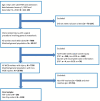Mental health in public safety personnel with workplace injuries requiring surgery: a longitudinal population-wide administrative data study in Manitoba, Canada
- PMID: 39920070
- PMCID: PMC11808913
- DOI: 10.1136/bmjopen-2024-084367
Mental health in public safety personnel with workplace injuries requiring surgery: a longitudinal population-wide administrative data study in Manitoba, Canada
Abstract
Objectives: Public safety personnel (PSP) are responsible for ensuring the safety and security of communities, often putting their own lives and well-being at risk by performing dangerous and demanding work. As a result, these workers are particularly vulnerable to workplace-related physical and mental traumatic injuries. Research is needed to understand the mental health of PSP following traumatic physical injury to inform effective prevention programmes and interventions. The objective of this study was to investigate whether PSP with traumatic physical workplace injuries requiring surgery with anaesthetic have higher post-injury rates of mental disorders compared with the general population with similar non-workplace injuries.
Design: Retrospective longitudinal cohort study.
Setting: Population-based study using linked anonymised administrative data for PSP and the general population in Manitoba, Canada.
Participants: This study compared two groups hospitalised for a traumatic physical injury requiring surgery with anaesthetic between 1 January 2002 and 31 December 2018: (1) PSP (n=293) injured in the workplace and matched 1:5 on sex, age, geographical region and surgical procedure code with (2) individuals in the general population (GenPop) injured outside the workplace (no Workers Compensation Board claim) (n=1198).
Primary and secondary outcomes and measures: As planned in the study protocol, the prevalence of mental disorders including anxiety, depression and substance use was measured in the cohorts 2 years pre- and post-injury.
Results: This study found an elevated unadjusted risk of depression in PSP compared with the general population in the 2 years post-injury, adjusting for pre-injury mental health (rate ratio, 1.49; 95% CI, 1.02 to 2.17; p<0.0001). After adjusting, there were no significant differences in rates between the two cohorts; however, the significant group × care interaction term for depression suggests a greater risk for PSP compared with GenPop over time.
Conclusions: Our findings indicate that, compared with a matched cohort, PSP have an increased risk of depression from the pre-injury to post-injury period following a traumatic physical workplace injury. PSP have a unique mental health trajectory following workplace injury that should be considered when developing rehabilitation strategies for this important population.
Keywords: Anxiety disorders; Depression & mood disorders; EPIDEMIOLOGY; Health Services; Trauma management.
© Author(s) (or their employer(s)) 2025. Re-use permitted under CC BY-NC. No commercial re-use. See rights and permissions. Published by BMJ Group.
Conflict of interest statement
Competing interests: None declared.
Figures
Similar articles
-
Mental and physical health disorders following paediatric traumatic injury: a population-based longitudinal study in Manitoba, Canada.BMJ Open. 2025 Mar 5;15(3):e097564. doi: 10.1136/bmjopen-2024-097564. BMJ Open. 2025. PMID: 40044202 Free PMC article.
-
Mental health: a cause or consequence of injury? A population-based matched cohort study.BMC Public Health. 2006 May 2;6:114. doi: 10.1186/1471-2458-6-114. BMC Public Health. 2006. PMID: 16650287 Free PMC article.
-
Return to Work Experiences of Ontario Public Safety Personnel with Work-Related Psychological Injuries.J Occup Rehabil. 2023 Dec;33(4):796-807. doi: 10.1007/s10926-023-10114-6. Epub 2023 Apr 6. J Occup Rehabil. 2023. PMID: 37022655 Free PMC article.
-
[Effectiveness of Mobile Apps and Text Messaging as an E-mental Health Intervention for the Three Most Common Operational Stress Injuries among Public Safety Personnel: A Review of Meta-Analyses and Systematic Reviews].Sante Ment Que. 2021 Spring;46(1):251-275. Sante Ment Que. 2021. PMID: 34597497 Review. French.
-
Workplace Injury Compensation and Mental Health and Self-Harm Outcomes: A Systematic Review.New Solut. 2024 Aug;34(2):71-82. doi: 10.1177/10482911241254836. Epub 2024 May 20. New Solut. 2024. PMID: 38767147 Free PMC article.
Cited by
-
Mental and physical health disorders following paediatric traumatic injury: a population-based longitudinal study in Manitoba, Canada.BMJ Open. 2025 Mar 5;15(3):e097564. doi: 10.1136/bmjopen-2024-097564. BMJ Open. 2025. PMID: 40044202 Free PMC article.
References
-
- Oliphant RC. Healthy minds, safe communities: supporting our public safety officers through a national strategy for operational stress injuries. 2016. [18-Sep-2023]. https://publications.gc.ca/site/eng/9.825367/publication.html Available. Accessed.
-
- American Psychiatric Association . Diagnostic and Statistical Manual of Mental Disorders. American Psychiatric Association; 2013. https://psychiatryonline.org/doi/book/10.1176/appi.books.9780890425596 Available. - DOI
MeSH terms
LinkOut - more resources
Full Text Sources
Medical
Research Materials
Miscellaneous

